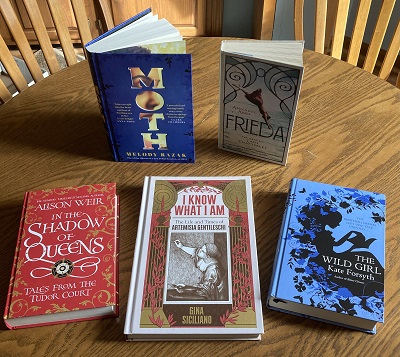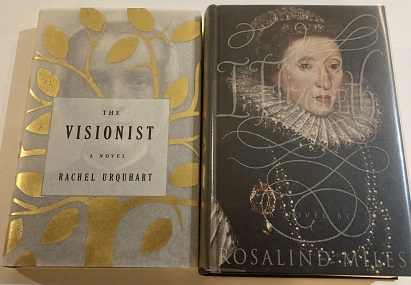Please help me welcome Carolyn Korsmeyer with a post about re-creating the world of Charlotte Lucas from Pride and Prejudice, and what she learned over the course of the writing process. Her explanation of the differences between approaching a setting from the viewpoint of a reader vs. that of a writer really resonated with me.
~
Researching and Writing Charlotte's Story
Carolyn Korsmeyer
I have been drawn to historical fiction since I first learned to read, but my first attempt at writing it came when I wrote a novel in the voice of one of Jane Austen's characters, Charlotte Lucas of
Pride and Prejudice. It was her realistic, dispassionate, and cool decision to wed the Reverend William Collins that interested me, because I thought reflection on that choice might resonate with contemporary readers in ways that extend beyond Austen's own times.
It was intriguing to imagine the inner life of a woman who faced some of the same choices as we do today, and yet was hindered by customs and limits that no longer exert the same force—although they have by no means disappeared. I decided to write a first-person narrative so that her own thoughts and worries were immediately accessible on the page. Her ruminations needed to conform reasonably well with early nineteenth-century sensibilities, but they also needed to ring true to readers today.
Charlotte is a middle-class woman with few financial resources of her own. She is not particularly pretty, so a stable and prosperous future more or less depends on making a good marriage. It might seem, to use contemporary language, that she "settles" on an unattractive man of means whom few others would want. That, however, is not quite the way I imagined it. Charlotte recognizes and accepts social restrictions that women today would not, and she is not inclined to be rebellious. (Unlike the heedless Lydia Bennet, for instance.) On the other hand, she is also not passive. She is strategic, in her own words "conniving," when the need arises.
Austen is still so popular that for many readers her novels almost achieve the familiarity that we find with contemporary fiction. That was my own impression when I launched into writing
Charlotte's Story. But then I began to stumble over details about her household, the way she got from place to place, what she ate, what she wore, how long it took to walk from one neighbor to another, and so forth. Pretty soon I realized the difference between thinking you recognize a world as you read, and actually writing that world, when puzzles and uncertainties emerge.
The same thing, incidentally, has happened with my second historical novel, which is set in a place where I have lived for decades and whose history is very familiar. But when I actually began to write this story, its details demanded an unexpected amount of research. I think this demonstrates a deceptive and elusive distinction between reading—where you enter another world and feel at home—and writing—where inventing that world reveals your ignorance. It brings the gap between now and then into focus.
For
Charlotte's Story, I took off from the text of
Pride and Prejudice itself, imagining myself in the Bennet rooms (oh—but what's the floor plan?), walking into Meryton (how long does that take?), perhaps riding in a coach (what, actually, is a barouche?), stitching by the fire (how do you net a purse?) Immediately, I realized that I didn’t know as much as I thought I did.
Charlotte was brought into being just as the COVID pandemic shut us all down, so I was lucky that lots of virtual resources were available. I had recently joined the Jane Austen Society, and they held their 2020 annual meeting virtually. It was full of enlightening and entertaining events. I watched lectures on conveyances, clothing, dancing, manners. I took a virtual tour of Austen's home in Chawton. Later I tuned into lectures sponsored by local chapters. With the libraries all closed, I scoured my own shelves and read every nineteenth-century English novel I could find, plus some old travel literature that had landed in my attic. I looked up maps of English cities like Bath to see how their streetscapes had changed over time. And I also watched period-style movies and TV series, noting with some alarm when they came in for criticism regarding their historical accuracy (Wrong hairstyle! Inappropriate shoes!).
 |
| author Carolyn Korsmeyer |
However, the errors to guard against are far from just factual. There is also the question of style and tenor of writing, which keeps a narrative in tune with the time of its settings. For example, the dialogue exchanged in Austen's own novels is far more elaborate and repetitive than would be common now, but Charlotte and her friends needed to converse in a manner that fit their times. It isn't a good idea just to try to imitate a style; rather one needs to find a tone and vocabulary that is congenial with an older one, but that also flows naturally for contemporary readers.
Even more subtle are the distortions that might enter one's writing when developing a character from the past. It is fascinating to wonder how influenced we all are by our own times and cultures. If we lived two centuries ago, would we have the same values and attitudes and feelings? Are there universals that apply to all people at all times? Perhaps the very basic ones do: we fear danger, we worry about children, are angry at insults, and so forth. But we are by no means insulted at the same things, and our worries and fears have quite different content now. (Think of Geraldine Brooks's wonderful novel
Caleb's Crossing and the way she conjures a fear of hell in her Puritan characters.) Literature that was written in the past gives us hints about those similarities and differences, and fiction can explore them still further. The historical fiction writer can be seen as a historian of emotions as well as of actions, characters, and plots from long ago.
~
About Charlotte's Story (TouchPoint Press; on-sale October 11th; ISBN: 978-1-952816-58-1; trade paperback and ebook editions):
Charlotte Lucas, a character first appearing in Jane Austen’s
Pride and Prejudice, has made an unfortunate marriage to the loquacious William Collins, reckoning that his tedious conversation is a small price to pay for the prosperous home and family she hopes to gain. However, trouble brews within the first months of marriage, and she is upset and angered by his presumptuous tendency to interfere with her friendships.
To ease the strain of their relationship, Charlotte leaves her husband to visit the fashionable city of Bath with several women companions. The weeks in Bath prove to be a time for self-discovery and freedom, even license. Although the marital frost between Charlotte and William begins to thaw, that tranquility lasts only briefly, for events in Bath have resulted in an unfortunate, even calamitous, consequence.
Charlotte devises a solution to the advantage of all that combines bold connivance and compassionate duplicity. Some would castigate her audacious stratagem, but she believes it justified by the hope of happiness and the wit and courage to seek it.
About the author:
A longtime admiration of Jane Austen and other nineteenth-century women novelists led Carolyn Korsmeyer to write
Charlotte’s Story. She is also the author of numerous philosophical works, including
Things: In Touch with the Past,
Savoring Disgust: The Foul and the Fair in Aesthetics, and
Making Sense of Taste: Food and Philosophy. Her website is
https://www.carolynkorsmeyer.com.




















